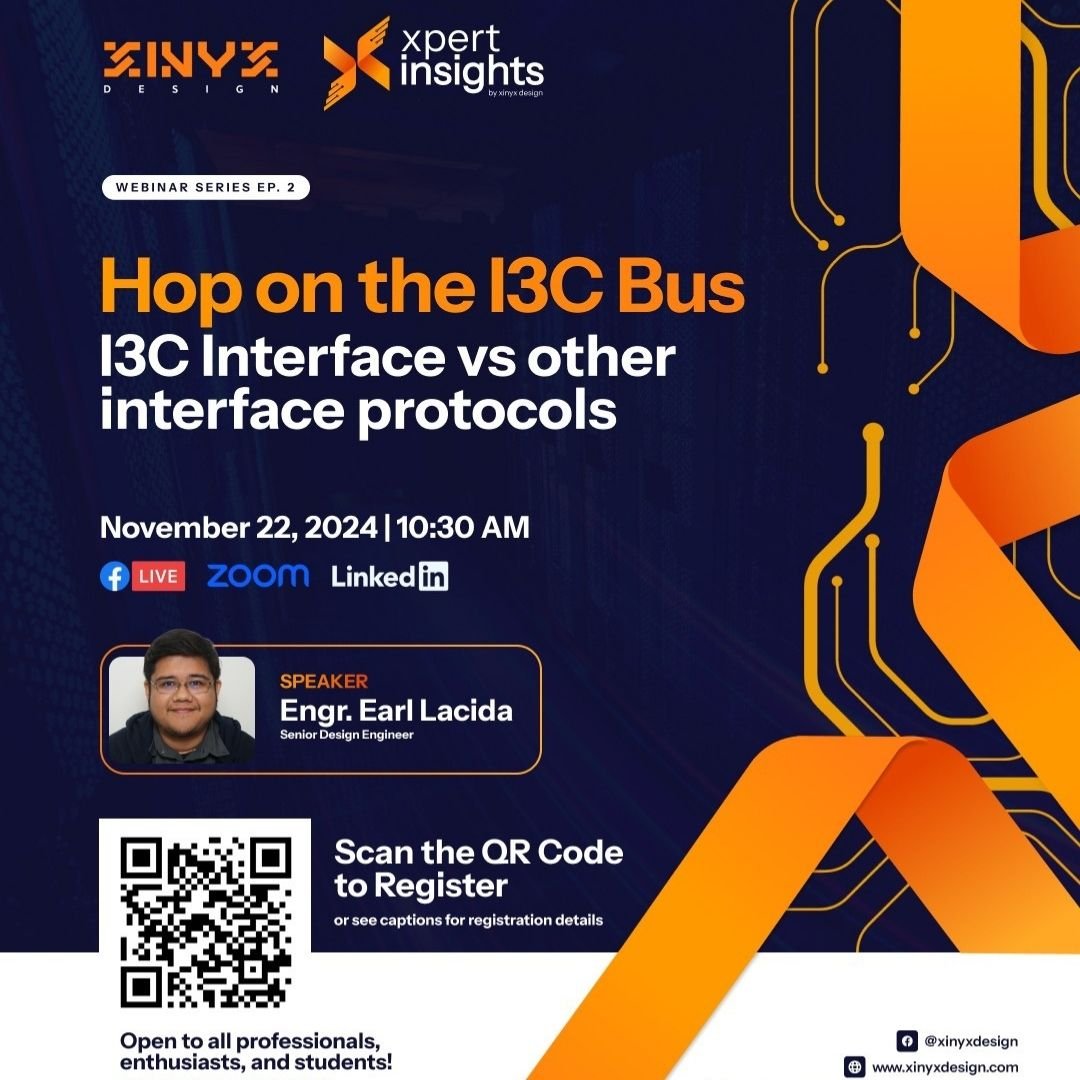On November 22, 2024, I spent my morning attending an informative webinar titled “Hop on the I3C Bus: I3C Interface vs. Other Interface Protocols,” organized by Xinyx Design Consultancy and Services Inc. Led by Engr. Earl Lacida, a Senior Designer Engineer, the session began promptly at 10:30 AM and offered a comprehensive overview of interface protocols in electronics.
The webinar followed a logical structure, starting with an introduction to interface protocols and covering the older I2C system before explaining I3C technology and its functionality. What I found particularly valuable was how Engr. Lacida thoroughly compared I3C with the older I2C standard, highlighting the numerous improvements that I3C brings to the table. He also provided insightful comparisons between I3C and other common protocols like SPI, UART, and CAN. Throughout the presentation, he addressed the limitations of older protocols, demonstrated how I3C resolves these issues, and shared real-world examples of I3C applications in current devices.
The session concluded with a helpful question-and-answer segment, where participants could directly engage with Engr. Lacida about any aspects they didn’t fully understand or wanted to explore further. This interactive component helped clarify lingering questions and provided personalized insights.
Before attending this webinar, my understanding of interface protocols was limited to the basics covered in my courses. Now I comprehend why I3C represents an advancement over older connection methods like I2C, SPI, UART, and CAN. I was intrigued to learn that I3C combines the best elements of these legacy systems while introducing significant improvements in communication speed, power efficiency, and flexibility. Engr. Lacida clearly explained how older protocols struggled with issues such as slow data rates, limited throughput, and excessive power consumption—all problems that I3C addresses effectively.
I was particularly struck by I3C’s ability to facilitate communication between devices operating at different speeds on the same connection without complications—a challenge for older systems. I also appreciated learning that I3C requires fewer physical wires than legacy systems, resulting in simpler and more cost-effective device construction. These advancements are crucial for developing superior electronics that are both more affordable and more efficient.
The advanced features of I3C, such as “in-band interrupts” and “dynamic address assignment,” were eye-opening. While initially sounding complex, I now understand how these features allow devices to manage communications more efficiently without requiring additional hardware or complex programming. This insight helped me envision how future smart devices can achieve greater efficiency and user-friendliness.
As a student inspired by this webinar, I’m excited to apply this knowledge in practical ways when working on electronic projects involving multiple communicating components. For instance, if I’m developing a project with various sensors (temperature, motion, light), implementing I3C instead of I2C could significantly enhance performance speed and optimize battery consumption—ideal for applications like smart home devices, wearable fitness trackers, or environmental monitoring systems.
This newfound understanding of different protocols enables me to make more informed decisions when planning projects. I can now select the most appropriate connection type (I3C, I2C, SPI, etc.) based on specific priorities such as speed, power consumption, simplicity, or cost. For straightforward devices with minimal communication requirements, I might still opt for I2C for its simplicity. However, for more complex systems with numerous interacting components, I would definitely consider I3C as the superior choice.
I found the webinar exceptionally well organized from beginning to end. The information was presented in a logical sequence that facilitated understanding, with basic concepts introduced first before progressing to more complex comparisons. This structured approach accommodated participants with varying levels of prior knowledge about interface protocols.
Engr. Lacida proved to be an excellent presenter who explained technical concepts with remarkable clarity. He used accessible language whenever possible and took care to define technical terms when necessary. His explanations struck an ideal balance—thorough yet not overwhelming—keeping everyone engaged throughout the presentation.
While the webinar was well-executed, I believe future technical sessions would benefit from additional visual aids. Though the presentation included some diagrams, incorporating more comparison charts, simple illustrations, or side-by-side visual comparisons would further clarify the differences between protocols. Visual learners especially would appreciate seeing how wiring configurations differ or how data flows in each protocol.
The addition of a short live demonstration would also greatly enhance the learning experience. Even a simple setup demonstrating I3C in comparison to I2C would help bridge theory with practical application. Observing the actual speed differences or connection methods would make I3C’s benefits more tangible and memorable.
Additionally, providing post-webinar resources would extend the value of the session. Materials such as a downloadable PDF summary of key points, links to further learning resources, or basic code examples would support participants in applying their new knowledge to personal projects. A follow-up email containing these resources would be a simple yet effective way to provide this additional support.

